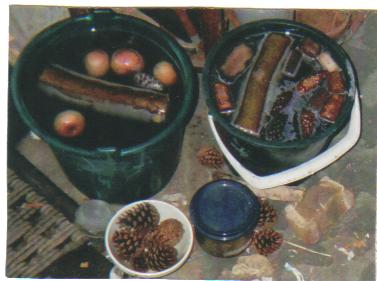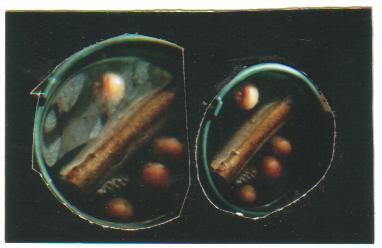
two pails

In it there is a greater quantity of white bacteria present. What is odd is that only the nearly emergent tops of these and other pinecones are stained white while it is the submerged upper parts of the wood and apples, which develop this white film. To some extent it just defines a waterline on inert materials, such as the plastic bucket and floating coconuts; but on the cones it also extends higher than this level film. Consequently when coconuts are removed and dried one can see a waterline of white or grey bacterial and algal staining present where they spent most of their time floating, and this also provides clues in Nature about drifting orientations on shells since I have recently cut some wood in the garden, due to the drought/subsidence problem outlined previously. It was interesting to compare the densities of instantaneously cut and floated wood in their summer state of moisture. Hawthorne logs sank straight away in seawater, but samples left ash cut ends on the tree before further cutting sometimes floated for a few minutes. Elder wood generally sank instantaneous but a few samples did float without drying, but only for a few days. When that is the case then longer sections of wood, termed logs, float longer than slices cut from between them, due to rates of water and air inside the structure being involved. Also as one moves from the stem to the thin twigs, even of Hawthorne, the floatation times increase, presumably because the new wood is less dense. Thus when one considers a less dense wood such as Ash, the twigs can float longer than the logs because they are initially less dense and more liable to dry if left on the ground. On the other hand the logs float longer than smaller slices of the same density and some twigs, due to rates of waterlogging and decay being increased when the surface to volume ratio is larger in a smaller structure. In a further complication seasonal variations in moisture change both the initial density and the rates of waterlogging. The photograph shows two logs of an Ash Fraxinus still floating after 7 days, compared to one and two days for the wood slices of 10 to 20mm length which were cut off them before floatation.

2 pails

The logs have a length around 195 mm and diameters around 65 mm, representing the base of a major twenty-year old branch. Judging from previous tests done at this time of year on an adjacent branch these logs may only float in these buckets until November, while the record for Ash twigs is held by one cut in November 30 2000 that sank after 276 days (diameter 19mm, cut to 74 mm length and kept in plastic bag until floated December 16 2000).
The associated floating objects in the left hand bucket are four apples of Malus domestica Borkhausen which fell from the tree and were floated in the morning of September 8 2006 (out of a sample of 10, 4 have sunk, 2 others float in another container), a wine cork made from Quercus suber L. which has nearly sunk after being floated on March 12 2001 (it can hardly be seen in the photograph, being tilted up and almost submerged) and the last of a batch of 8 Pinus nigra Arnold cones collected and floated on September 11 2006. The other bucket shows some driftwood, stranded corks and more recently collected cones from below the same tree. The record from Pinus nigra cones from that tree is currently held by two that fell in winter and floated for 65 days after January 7 2002. This is somewhat mysterious since drier; more open summer cones might be expected to float longer. Colder experimental conditions in winter and the larger size of the cones available that day probably explain that anomaly.
No comments:
Post a Comment